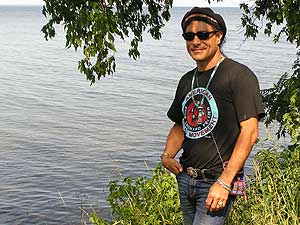|
Audio
Photos
Resources
Your Voice
|
A rock star from Indian Country
September 7, 2004
 |
| Robby Romero calls his music Native rock. He'll bring his music to several Minnesota tribes in October, performing at concerts intended to get out the vote. (MPR Photo/Annie Baxter) |
Onamia, Minn. — It's a sunny afternoon on the Mille Lacs reservation. Robby Romero is in town visiting from the southwest, where he lives. We're in a car headed to Lake Mille Lacs to find a pretty spot to sit and talk.
Romero puts on some music he's working on with his band, Red Thunder. Folk rock guitar riffs blend with traditional instrumentation.
 | |||
"My music is a woven blanket of traditional instruments with contemporary instruments," Romero says. "It doesn't start with traditional and fade out into the contemporary. I call it Native rock."
Romero has forged an identity as a Native artist. He distributes and performs almost exclusively in Indian Country -- that's a widely used term that signifies the homelands and reservations of Native peoples.
"The term Indian Country probably came from the Department of War, for enemy lines. You crossed into Indian Country. But Indian Country today is the reservations, the tribes that do not have ratified treaties with the United States -- that are landless. We're a band that comes from Indian Country," Romero explains.
Romero is Apache and comes from New Mexico. But he spent a good chunk of his childhood in Hollywood. His dad worked in film and his mom was a dancer. She appeared in several Elvis Presley movies.
As a kid, Romero was surrounded by artists, including the actor and director Dennis Hopper. On the shores of Lake Mille Lacs, Romero tells the story of a concert he attended with Dennis Hopper. Romero was a young teenager. He says a band called Xit opened his eyes to musical possibilities and, really, to ways of being Indian.
 | |||
"They started the set with this traditional pow-wow drum, traditional singing," Romero recalls. "And they were all very much dressed in a contemporary Native way, kind of like during the Indian wars how Geronimo dressed -- how he was using contemporary clothing that was being introduced but he was Indianizing it. He was making it Apache, making it his own."
"And these guys looked like that, only it was the '70s. They went into some rock and roll music," says Romero. "Their set hit me; I never forgot it. I knew then I wanted to take it to another level of getting rid of trap set drums and bringing in traditional drums."
But Romero wasn't making Native rock from the beginning. As a teenager, he played guitar and wrote original songs. He toured with artists like country singer Ronee Blakely and blues musician Paul Butterfield. He'd open for them and sometimes played in their bands, as well.
Then drug addiction landed Romero in treatment. And he turned to his roots and traditional ceremonies to get better. That launched him on a new path. He became active in the American Indian Movement. He began making films about sacred sites and the environment. And he started his Native rock band, Red Thunder.
Romero and his band have reached wide audiences. His 1998 film, "Hidden Medicine," premiered at the Sundance Film Festival and played on the Sundance Channel.
|
I think the mainstream's ready for a lot of things that they don't have access to. I think there are some wonderful Native artists out there that the mainstream would love. I think the music industry kind of categorizes Native artists as artists by race.
- Robby Romero |
Red Thunder has played international gigs at United Nations summits and the Kremlin. But still, the band hasn't quite penetrated the mainstream. Romero thinks that's a problem with the industry itself.
"I think the mainstream's ready for a lot of things that they don't have access to. I think there are some wonderful Native artists out there that the mainstream would love. I think the music industry kind of categorizes Native artists as artists by race," Romero argues.
And that has a strange consequence. Since Romero's music is closely identified with the category Native rock, it isn't always heard by Native American people.
At a grocery store on the Mille Lacs reservation, local band members say they didn't know Romero's music. They listen to more mainstream radio fare.
And over at the tribal school, principal Rick Gresczyk says he doesn't know Romero either. Two teenage girls are standing nearby as he speaks. They've never even heard of Native rock. Grescyk explains how some contemporary Native music is what you hear in the soundtrack of movies like "Skins" or "Pow-wow Highway."
"When it's not pow-wow music, it's a lot of times like Indian folk music," Gresczyk says.
Though not a household name today, Romero might be developing a higher profile at the Mille Lacs reservation. He recently performed at one of the band's private events. And in October, he'll perform again at Mille Lacs and at other Minnesota reservations, to encourage people to vote in the national election.
In the meantime, he continues to work on film projects, which he hopes will expand his audience.
|
News Headlines
|
Related Subjects
|
